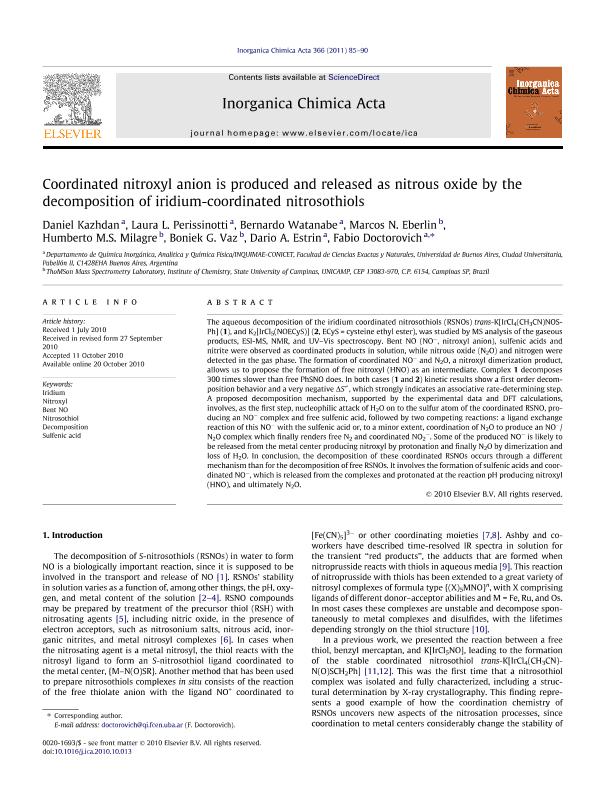Artículo
Coordinated nitroxyl anion is produced and released as nitrous oxide by the decomposition of iridium-coordinated nitrosothiols
Kazhdan, Daniel; Perissinotti, Laura Lucia ; Watanabe, Bernardo; Eberlin, Marcos N.; Milagre, Humberto M. S.; Vaz, Boniek G.; Estrin, Dario Ariel
; Watanabe, Bernardo; Eberlin, Marcos N.; Milagre, Humberto M. S.; Vaz, Boniek G.; Estrin, Dario Ariel ; Doctorovich, Fabio
; Doctorovich, Fabio
 ; Watanabe, Bernardo; Eberlin, Marcos N.; Milagre, Humberto M. S.; Vaz, Boniek G.; Estrin, Dario Ariel
; Watanabe, Bernardo; Eberlin, Marcos N.; Milagre, Humberto M. S.; Vaz, Boniek G.; Estrin, Dario Ariel ; Doctorovich, Fabio
; Doctorovich, Fabio
Fecha de publicación:
01/2011
Editorial:
Elsevier Science Sa
Revista:
Inorganica Chimica Acta
ISSN:
0020-1693
Idioma:
Inglés
Tipo de recurso:
Artículo publicado
Clasificación temática:
Resumen
The aqueous decomposition of the iridium coordinated nitrosothiols (RSNOs) trans-K[IrCl4(CH3CN)NOSPh] (1), and K 2[IrCl5(NOECyS)] (2, ECyS = cysteine ethyl ester), was studied by MS analysis of the gaseous products, ESI-MS, NMR, and UV-Vis spectroscopy. Bent NO (NO-, nitroxyl anion), sulfenic acids and nitrite were observed as coordinated products in solution, while nitrous oxide (N2O) and nitrogen were detected in the gas phase. The formation of coordinated NO- and N2O, a nitroxyl dimerization product, allows us to propose the formation of free nitroxyl (HNO) as an intermediate. Complex 1 decomposes 300 times slower than free PhSNO does. In both cases (1 and 2) kinetic results show a first order decomposition behavior and a very negative ΔS≠, which strongly indicates an associative rate-determining step. A proposed decomposition mechanism, supported by the experimental data and DFT calculations, involves, as the first step, nucleophilic attack of H 2O on to the sulfur atom of the coordinated RSNO, producing an NO- complex and free sulfenic acid, followed by two competing reactions: a ligand exchange reaction of this NO- with the sulfenic acid or, to a minor extent, coordination of N2O to produce an NO -/N2O complex which finally renders free N2 and coordinated NO2-. Some of the produced NO- is likely to be released from the metal center producing nitroxyl by protonation and finally N2O by dimerization and loss of H2O. In conclusion, the decomposition of these coordinated RSNOs occurs through a different mechanism than for the decomposition of free RSNOs. It involves the formation of sulfenic acids and coordinated NO-, which is released from the complexes and protonated at the reaction pH producing nitroxyl (HNO), and ultimately N2O.
Palabras clave:
Bent No
,
Decomposition
,
Iridium
,
Nitrosothiol
,
Nitroxyl
,
Sulfenic Acid
Archivos asociados
Licencia
Identificadores
Colecciones
Articulos(INQUIMAE)
Articulos de INST.D/QUIM FIS D/L MATERIALES MEDIOAMB Y ENERGIA
Articulos de INST.D/QUIM FIS D/L MATERIALES MEDIOAMB Y ENERGIA
Citación
Kazhdan, Daniel; Perissinotti, Laura Lucia; Watanabe, Bernardo; Eberlin, Marcos N.; Milagre, Humberto M. S.; et al.; Coordinated nitroxyl anion is produced and released as nitrous oxide by the decomposition of iridium-coordinated nitrosothiols; Elsevier Science Sa; Inorganica Chimica Acta; 366; 1; 1-2011; 85-90
Compartir
Altmétricas



